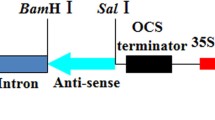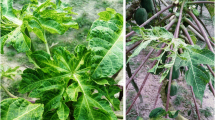Abstract
R1 plants of the transgenic papaya line 55-1, which expresses a single coat protein (CP) gene of the mild strain of the papaya ringspot virus (PRSV) HA from Hawaii, were previously shown to be resistant only to PRSV isolates from Hawaii. Two transgenic papaya cultivars were subsequently derived from line 55-1. UH SunUp (SunUp) is homozygous for the CP gene insertion and UH Rainbow (Rainbow) is hemizygous for the CP gene because it is a F1 hybrid of a cross between SunUp and the nontransgenic papaya cultivar Kapoho. To determine the various parameters that affect the resistance of SunUp and Rainbow, plants at different developmental stages (younger and older) were inoculated with PRSV isolates from Hawaii, Brazil, Jamaica, and Thailand. Hawaiian isolates shared nucleotide sequence identities of 96.7–99.8% to the CP transgene, and the other isolates shared sequence identities of 89.5–92.5%. Resistance was affected by CP gene dosage, plant developmental stage, and CP sequence identity of the challenge isolate. Young and older hemizygous Rainbow plants were resistant to the homologous PRSV HA (99.8% homology to CP transgene), while only older Rainbow plants were resistant to the other Hawaiian isolates (96.7% homology). However, all inoculated Rainbow plants were susceptible to PRSV isolates collected from Jamaica, Brazil, and Thailand. In contrast, SunUp was resistant to all PRSV isolates, except the one from Thailand, regardless of the plant developmental stage. Resistance to the Thailand isolate, which shares 89.5% homology to the transgene, was observed only with SunUp plants inoculated at an older stage. Steady state RNA analysis and nuclear run-on experiments suggested that resistance of the transgenic papaya is RNA-mediated via post-transcriptional gene silencing.
Similar content being viewed by others
References
Baulcombe DC (1996) Mechanisms of pathogen-derived resistance to viruses in transgenic plants. Plant Cell 8: 1833-1844
Cabrera PJL, Vegas GA and Herrera EL (1995) Herbicide resistant transgenic papaya plants produced by an efficient particle bombardment transformation method. Plant Cell Reports 15: 1-7
de Carvalho F, Gheysen G, Kushnir S, M. VM, Inze D and Castresana C (1992) Suppression of beta-1,3-glucanase transgene expression in homozygous plants. European Molecular Biology Organization Journal 11: 2595-2602
Dehio C and Schell J (1994) Identification of plant genetic loci involved in a posttranscriptional mechanism for meiotically reversible transgene silencing. Proceedings of the National Academy of Sciences of the United States of America 91: 5538-5542
Dinant S, Maisonneuve B, Albouy J, Chupeau Y, Chupeau M, Bellec Y, Gaudefroy F, Kusiak C, Souche S, Robaglia C and Lot H (1997) Coat protein gene mediated protection in Lactuca sativa against lettuce mosaic potyvirus strains. Molecular Breeding 3: 75-86
Fagard M and Vaucheret H(2000) (Trans)gene silencing in plants: how many mechanisms? Annual Review of Plant Physiology and Plant Molecular Biology 51: 167-194
Feingberg J and Vogelstein B (1983) A technique for radiolabelling DNA restriction endonuclease fragments to high specific activity. Analytical Biochemistry 132: 6-13
Finnegan J and McElroy D (1994) Transgene inactivation: plants fight back! Bio/technology 12: 883-888
Fitch MMM, Manshardt RM, Gonsalves D, Slightom JL and Sanford JC (1990) Stable transformation of papaya via microprojectile bombardment. Plant Cell Reports 9: 189-194
Fitch MMM, Manshardt RM, Gonsalves D, Slightom JL and Sanford JC (1992) Virus resistant papaya derived from tissues bombarded with the coat protein gene of papaya ringspot virus. Bio/Technology 10: 1466-1472
Fuchs M and Gonsalves D (1995) Resistance of transgenic hybrid squash ZW-20 expressing the coat protein genes of zucchini yellow mosaic virus and watermelon mosaic virus 2 to mixed infections by both potyviruses. Bio/Technology 13: 1466-1473
Gonsalves D (1998) Control of papaya ringspot virus in papaya: a case study. Annual Review of Phytopathology 36: 415-437
Goodwin J, Chapman K, Swaney S, Parks TD, Wernsman EA and Dougherty WG (1996) Genetic and biochemical dissection of transgenic RNA-mediated virus resistance. Plant Cell 8: 95-105
Jan FJ, Fagoaga C, Pang SZ and Gonsalves D (2000) A single chimeric transgene derived from two distinct viruses confers multi-virus resistance in transgenic plants through homologydependent gene silencing. Journal of General Virology 81: 2103-2109
Ling K, Namba S, Gonsalves C, Slightom JL and Gonsalves D (1991) Protection against detrimental effects of potyvirus infection in transgenic tobacco plants expressing the papaya ringspot virus coat protein gene. Bio/Technology 9: 752-758
Lius S, Manshardt RM, Fitch MMM, Slightom JL, Sanford JC and Gonsalves D (1997) Pathogen-derived resistance provides papaya with effective protection against papaya ringspot virus. Molecular Breeding 3: 161-168
Lomonossoff GP (1995) Pathogen-derived resistance to plant viruses. Annual Review of Phytopathology 33: 323-343
Manshardt RM (1998) 'UH Rainbow’ papaya. University of Hawaii College of Tropical Agriculture and Human Resources Germplasm G-1: 2 pp
Matzke MA and Matzke AJM (1998) Epigenetic silencing of plant transgenes as a consequence of diverse cellular defence responses. Cellular and Molecular Life Sciences 54: 94-103
McDonald J, Brandle F, Gleddie S, Hermans J and Kermali I (1997) Resistance to homologous and heterologous strains of potato virus Y in transgenic tobacco carrying the PVY (N) coat protein gene. Canadian Journal of Plant Science 77: 167-171
Nagao M and Furutani S (1996) Improving germination of papaya seed by density separation, potassium nitrate, and gibberellic acid. HortScience 21: 1439-1440
Napoli C, Lemieux C and Jorgensen R (1990) Introduction of a chimeric chalcone synthase gene into petunia results in reversible co-suppression of homologous genes in trans. Plant Cell 2: 279-290
Pang S-Z, Jan F-J and Gonsalves D (1997) Nontarget DNA sequences reduce the transgene length necessary for RNA-mediated tospovirus resistance in transgenic plants. Proceedings of the National Academy of Sciences of the United States of America 94: 8261-8266
Pang SZ, Jan FJ, Carney K, Stout J, Tricoli DM, Quemada HD and Gonsalves D (1996) Post-transcriptional transgene silencing and consequent tospovirus resistance in transgenic lettuce are affected by transgene dosage and plant development. Plant Journal 9: 899-909
Quemada H, L'Hostis B, Gonsalves D, Reardon IM, Heinrikson R, Hiebert EL, Sieu LC and Slightom JL (1990) The nucleotide sequences of the 3-terminal regions of papaya ringspot virus strains w and p. Journal of General Virology 71: 203-210
Sambrook J, Fritsch EF and Maniatis T (1989) Molecular Cloning: A Laboratory Manual, 2nd edn, Cold Spring Harbor Laboratory, New York
Sanford JC and Johnston SA (1985) The concept of parasitederived resistance - Deriving resistance genes from the parasite's own genome. Journal of Theoretical Biology 113: 395-405
Slightom JL (1991) Custom polymerase-chain-reaction engineering of a plant expression vector.Gene 100: 251-256
Tennant PF, Gonsalves C, Ling KS, Fitch M, Manshardt R, Slightom JL and Gonsalves D (1994) Differential protection against papaya ringspot virus isolates in coat protein gene transgenic papaya and classically cross-protected papaya. Phytopathology 84: 1359-1366
Tricoli DM, Carney KJ, Russell PF, McMaster JR, Groff DW, Hadden KC, Himmel PT, Hubbard JP, Boeshore ML and Quemada HD(1995) Field evaluation of transgenic squash containing single or multiple virus coat protein gene constructs for resistance to cucumber mosaic virus, watermelon mosaic virus 2, and zucchini yellow mosaic virus. Bio/Technology 13: 1458-1465
Wang C-H and Yeh D-D (1997) Divergence and conservation of the genomic RNAs of Taiwan and Hawaii strains of papaya ringspot potyvirus. Archives of Virology 142: 271-285
Yeh SD and Gonsalves D (1984) Evaluation of induced mutants of papaya ringspot virus for control by cross protection. Phytopathology 74: 1086-1091
Yeh SD, Jan FJ, Chiang CH, Doong PJ, Chen MC, Chung PH and Bau HJ (1992) Complete nucleotide sequence and genetic organization of papaya ringspot virus RNA. Journal of General Virology 73: 2531-2541
Author information
Authors and Affiliations
Corresponding author
Rights and permissions
About this article
Cite this article
Tennant, P., Fermin, G., Fitch, M. et al. Papaya Ringspot Virus Resistance of Transgenic Rainbow and SunUp is Affected by Gene Dosage, Plant Development, and Coat Protein Homology. European Journal of Plant Pathology 107, 645–653 (2001). https://doi.org/10.1023/A:1017936226557
Issue Date:
DOI: https://doi.org/10.1023/A:1017936226557




